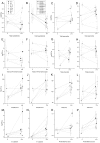Phenolic compounds and expression of 4CL genes in silver birch clones and Pt4CL1a lines
- PMID: 25502441
- PMCID: PMC4263613
- DOI: 10.1371/journal.pone.0114434
Phenolic compounds and expression of 4CL genes in silver birch clones and Pt4CL1a lines
Abstract
A small multigene family encodes 4-coumarate:CoA ligases (4CLs) catalyzing the CoA ligation of hydroxycinnamic acids, a branch point step directing metabolites to a flavonoid or monolignol pathway. In the present study, we examined the effect of antisense Populus tremuloides 4CL (Pt4CL1) to the lignin and soluble phenolic compound composition of silver birch (Betula pendula) Pt4CL1a lines in comparison with non-transgenic silver birch clones. The endogenous expression of silver birch 4CL genes was recorded in the stems and leaves and also in leaves that were mechanically injured. In one of the transgenic Pt4CL1a lines, the ratio of syringyl (S) and guaiacyl (G) lignin units was increased. Moreover, the transcript levels of putative silver birch 4CL gene (Bp4CL1) were reduced and contents of cinnamic acid derivatives altered. In the other two Pt4CL1a lines changes were detected in the level of individual phenolic compounds. However, considerable variation was found in the transcript levels of silver birch 4CLs as well as in the concentration of phenolic compounds among the transgenic lines and non-transgenic clones. Wounding induced the expression of Bp4CL1 and Bp4CL2 in leaves in all clones and transgenic lines, whereas the transcript levels of Bp4CL3 and Bp4CL4 remained unchanged. Moreover, minor changes were detected in the concentrations of phenolic compounds caused by wounding. As an overall trend the wounding decreased the flavonoid content in silver birches and increased the content of soluble condensed tannins. The results indicate that by reducing the Bp4CL1 transcript levels lignin composition could be modified. However, the alterations found among the Pt4CL1a lines and the non-transgenic clones were within the natural variation of silver birches, as shown in the present study by the clonal differences in the transcripts levels of 4CL genes, soluble phenolic compounds and condensed tannins.
Conflict of interest statement
Figures




Similar articles
-
Structural, functional and evolutionary diversity of 4-coumarate-CoA ligase in plants.Planta. 2018 Nov;248(5):1063-1078. doi: 10.1007/s00425-018-2965-z. Epub 2018 Aug 4. Planta. 2018. PMID: 30078075 Review.
-
Phenolic compounds in ectomycorrhizal interaction of lignin modified silver birch.BMC Plant Biol. 2009 Sep 29;9:124. doi: 10.1186/1471-2229-9-124. BMC Plant Biol. 2009. PMID: 19788757 Free PMC article.
-
Does lignin modification affect feeding preference or growth performance of insect herbivores in transgenic silver birch (Betula pendula Roth)?Planta. 2005 Nov;222(4):699-708. doi: 10.1007/s00425-005-0002-5. Epub 2005 Nov 4. Planta. 2005. PMID: 15971066
-
Decreased anthocyanidin reductase expression strongly decreases silver birch (Betula pendula) growth and alters accumulation of phenolics.Physiol Plant. 2015 Dec;155(4):384-99. doi: 10.1111/ppl.12324. Epub 2015 Feb 23. Physiol Plant. 2015. PMID: 25611902
-
Trends in lignin modification: a comprehensive analysis of the effects of genetic manipulations/mutations on lignification and vascular integrity.Phytochemistry. 2002 Oct;61(3):221-94. doi: 10.1016/s0031-9422(02)00211-x. Phytochemistry. 2002. PMID: 12359514 Review.
Cited by
-
Structural, functional and evolutionary diversity of 4-coumarate-CoA ligase in plants.Planta. 2018 Nov;248(5):1063-1078. doi: 10.1007/s00425-018-2965-z. Epub 2018 Aug 4. Planta. 2018. PMID: 30078075 Review.
-
Transcriptome profiling unveils the mechanism of phenylpropane biosynthesis in rhizome development of Caucasian clover.PLoS One. 2021 Jul 13;16(7):e0254669. doi: 10.1371/journal.pone.0254669. eCollection 2021. PLoS One. 2021. PMID: 34255805 Free PMC article.
-
Plant Secondary Metabolites with an Overview of Populus.Int J Mol Sci. 2021 Jun 26;22(13):6890. doi: 10.3390/ijms22136890. Int J Mol Sci. 2021. PMID: 34206964 Free PMC article. Review.
-
Transcriptome and weighted correlation network analyses provide insights into inflorescence stem straightness in Paeonia lactiflora.Plant Mol Biol. 2020 Feb;102(3):239-252. doi: 10.1007/s11103-019-00945-4. Epub 2019 Dec 12. Plant Mol Biol. 2020. PMID: 31832900
-
Heat Stress and Microbial Stress Induced Defensive Phenol Accumulation in Medicinal Plant Sparganium stoloniferum.Int J Mol Sci. 2024 Jun 9;25(12):6379. doi: 10.3390/ijms25126379. Int J Mol Sci. 2024. PMID: 38928085 Free PMC article.
References
-
- Buer CS, Imin N, Djordjevic MA (2010) Flavonoids: New roles for old molecules. J Integr Plant Biol 52:98–111. - PubMed
-
- Boeckler GA, Gershenzon J, Unsicker SB (2011) Phenolic glycosides of the Salicaceae and their role as anti-herbivore defenses. Phytochemistry 72:1497–1509. - PubMed
-
- Hichri I, Barrieu F, Bogs J, Kappel C, Delrot S, et al. (2011) Recent advances in the transcriptional regulation of the flavonoid biosynthetic pathway. J Exp Bot 62:2465–2483. - PubMed
-
- Cabane M, Afif D, Hawkings S (2012) Lignins and abiotic stress. In: Jouanin L, Lapierre C, editors. Lignins biosynthesis, biodegradation and bioengineering. US: Elsevier Ltd. pp. 219–261.
-
- de Bruxelles G, Roberts M (2001) Signals regulating multiple responses to wounding and herbivores. Crit Rev Plant Sci 20:487–521.
Publication types
MeSH terms
Substances
LinkOut - more resources
Full Text Sources
Other Literature Sources
Research Materials

